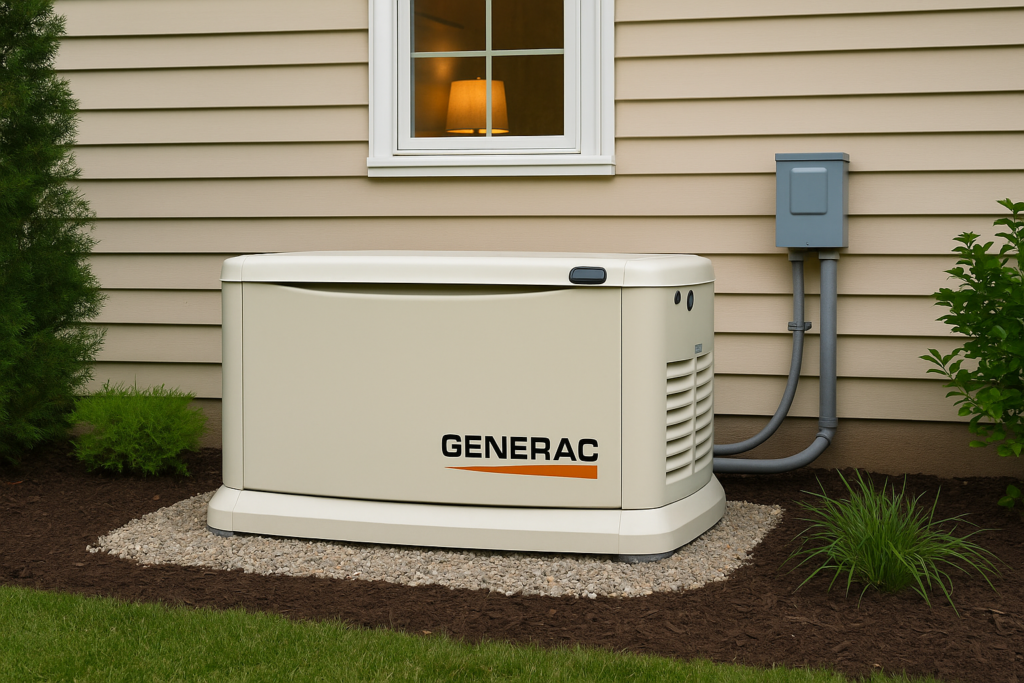How to Safely Connect a Generator to Your House
Your Guide to a Safe Generator Connection to House Power (No DIY Disasters Here)
When the power goes out in Michigan thanks to snow, wind, or a surprise summer thunderstorm, most homeowners start scrambling for flashlights, candles, and backup plans. But if you’ve got a generator connection to house power that’s properly installed and code-compliant, you can skip the panic and keep your heat, fridge, and Wi-Fi humming along like nothing happened.
In this article, we’ll break down how whole home standby generators and portable generators connect to your home, the safety gear that makes it possible, and why professional installation by Hartland Electric keeps you (and your home) protected.
What “Generator Connection to House” Really Means
When you connect a generator to your house, you’re creating a backup power source that automatically or manually takes over when the utility power fails.
There are two main connection types homeowners use:

1. Whole Home Standby Generators (The Generac Way)
These systems are permanently installed outside your home (like a central A/C unit) and automatically kick in the second your power goes out.
- They’re wired directly to your home’s electrical panel via an automatic transfer switch.
- They run on natural gas or propane, meaning no messy refueling.
- They turn on automatically and power the entire house (or just the circuits you choose).
Think of a Generac whole home generator as the Cadillac of backup power- fully automatic, low-maintenance, and built for long-term reliability.
2. Portable Generators (The DIY Option)
These are the smaller, gas-powered units you can buy from places like Lowe’s, Costco, or Home Depot. They’re great for short-term power outages but require manual setup:
- You have to start it manually when the power goes out.
- You’ll need to run extension cords or use a manual transfer switch.
- You’ll have to refuel it every few hours.
In short: Portable generators work in a pinch, but whole home standby systems work seamlessly.
The Power Player — Transfer Switches
Here’s the golden rule: never plug a generator directly into your home’s outlets or panel without a transfer switch.
That’s called “backfeeding,” and it’s both illegal and dangerous– it can send electricity back through the power lines, endangering utility workers and damaging your home’s wiring.
How a Transfer Switch Works
- It safely isolates your home’s electrical circuits from the grid during an outage.
- It switches power sources automatically (for standby generators) or manually (for portable ones).
- It ensures your generator only powers what it’s meant to, and does so safely.
💡 Pro Tip: A properly installed transfer switch is what separates a professional setup from a potential fire hazard.
Why Professional Installation Matters
It’s tempting to think you can DIY a generator connection to your house, but this is one of those projects that’s better left to the pros.
Here’s Why:
- Code Compliance: Electrical codes require permits, inspections, and licensed installation.
- Safety: A small mistake in wiring can lead to fires or electrocution.
- Insurance: Many homeowner insurance policies won’t cover DIY electrical work.
- Reliability: Professional installation means your generator starts and runs automatically when you need it most.
According to Generac, nearly 70% of power outages in the U.S. are caused by severe weather, and the average outage lasts over 7 hours. (That’s plenty of time for your basement sump pump to stop working, or your fridge to spoil hundreds of dollars’ worth of groceries.)
A properly installed generator connection gives you peace of mind that your home will keep running smoothly, no matter what Michigan throws your way.
Whole Home vs. Portable Generator Connections — Quick Comparison
Feature | Whole Home Standby Generator | Portable Generator |
Activation | Automatic | Manual |
Fuel Type | Natural gas or propane | Gasoline |
Power Capacity | Whole house | Limited circuits/devices |
Run Time | Continuous | 6–10 hours per tank |
Noise Level | Low | Moderate to loud |
Maintenance | Annual check-up | Frequent refueling |
Installation | Permanent, professional | Temporary, DIY |
Best For | Long-term reliability | Occasional short outages |
Trust Hartland Electric for a Safe Generator Connection to Your House
When it comes to connecting a generator to your house, it’s not just about convenience, it’s about safety, reliability, and long-term protection.
At Hartland Electric, our licensed electricians handle every part of the process:
- Code-compliant installation
- Proper transfer switch setup
- Seamless integration with your home’s electrical system
- Thorough testing to ensure you’re outage-ready
If you’re considering a Generac whole home generator or want to ensure your current system is connected safely, call the experts at Hartland Electric today.
